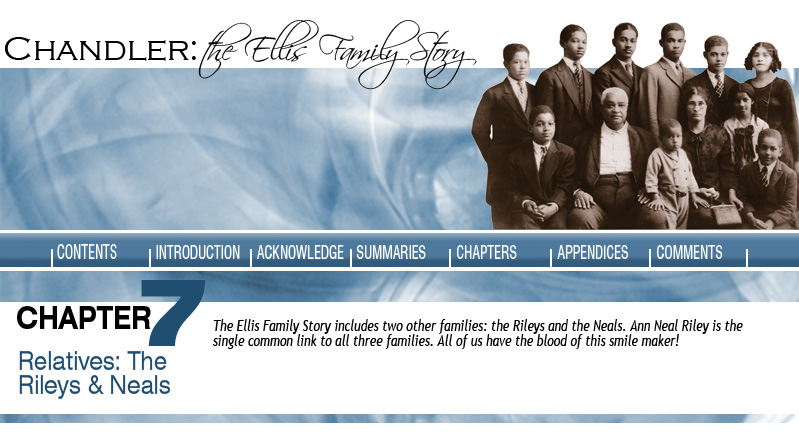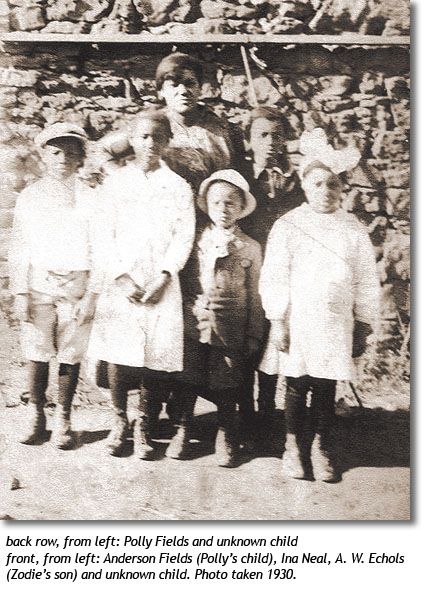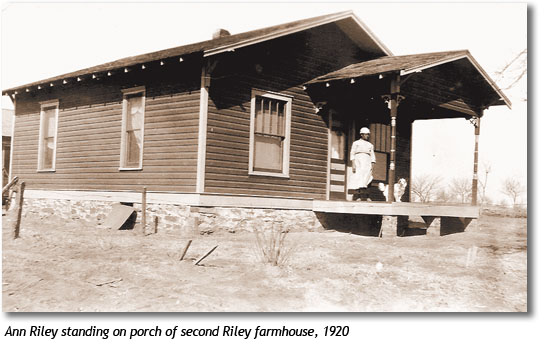
|
The Riley’s are the smallest clan and consist of James and Ann Riley and their four children. One of their children is Maggie Ellis. As you know, she is the mother of all the Ellises in our story. The Riley connection comes from the marriage of Maggie’s parents, James Riley and Ann Neal Riley. Winfield Riley and his wife, Marcena, their seven children and grandchildren, are the only ones that continued to carry the Riley name. The Neals are all the parents and siblings of Ann Neal Riley, James Riley’s wife. After arriving in Oklahoma, all three families remained closely connected. Genealogy charts in Appendices B and C show their relationship.
With the exception of Maggie, the Rileys in our story all descended from the 1884 marriage of James Riley and Ann Neal. As you recall, Maggie was born prior to that marriage. James and Ann raised four children — Maggie, Polly, Winfield, and Zodie. Polly and her husband, Agustus Fields, had two children — Anderson and Myrtle; Winfield and his wife, Marcina, had seven offsprings — Sam, Harvey, Marvin, Winfield Jr., Peggy, Shirley, and Stephen; Zodie and her husband, Anthony Echols, had only one child – Anthony Echols Jr.; and the eldest daughter, Maggie, had 11 children. All the children of James and Ann Riley grew up in Chandler. This was not the case with the Neals.
The Neals are relatives of Ann Riley. Ann Riley’s father and mother are Agustus and Lucinda Neal. The Neal children consists of Ann (Grandma Riley), Oliver James, John, George, Marcellus, Clearance, Frank, Louis, Victoria, and Fannie. They grew up in Texas. The parents — John, Marcellus, and George — ultimately resettled in Chandler. It is not clear if they came with James and Ann Neal Riley in 1889 or later. Our best guess is that they arrived in the early 1900s, after James and Ann Riley. Eventually, most of the children of Agustus and Lucinda settled in Chandler. Agustus Neal died in 1917 and is buried at Chandler’s Clearview Cemetery. He rests under a unique, hand-carved stone. James Ellis was present when Marcellus Neal performed the tedious task of carving his father’s name in the soft stone. Only his name is recorded. The small stone was not large enough for other details and stands out among the machine-carved and polished monuments in Clearview Cemetery. We believe James Riley and his family arrived in the Chandler area in 1890, shortly before the 1891 land rush. However, they did not participate in the land rush. It is not clear why they chose not to do so. One possibility is that Rileys may have initially farmed a homestead site in Sweethome, a small community about 8 miles northwest of Chandler. On a 1903 Lincoln County land ownership map, the Rileys are listed as owners of a 20-acre plot of land just south of Chandler. We believe that James Riley purchased this plot of farmland in the mid-1890s. The Riley farm is still in the family and deserves more than casual attention. For many years it was the “Chandler headquarters” for the Riley, Neal, and Ellis families.
The Riley farmland was purchased from Mr. Hoyt who had originally obtained a 160-acre plot of land during the 1891 land rush. He subsequently sold half of the farmland to James Riley and several other people.
In 1910, the Rileys began constructing the original farmhouse. In 1919, a second farmhouse was built less than 100 yards from the original one. The carpenters for the second house were James’ and Ann’s son, Winfield; Grandma Riley’s brother, Marcellus; and one white carpenter. After three days on the job, Grandma Riley dismissed the white carpenter. Her explanation was short, “You don’t know what ya doin and don’t need to come back.” The construction was completed by Winfield and Marcellus, with additional labor contributed by whoever was handy. The farmhouse consisted of a small living room, two bedrooms, and a cooking area. A smokehouse was later added just behind the main structure. Today, the farmhouse still stands. Ann Riley was quick to notice the extra work caused by having two houses. The original farmhouse was torn down soon after the new one was constructed.
The above photo is of the second farmhouse. It appears to be of similar size and shape as the first one. No one knows why it was built. The only justification is that it is what Grandma Riley desired. The Riley farm was always a beehive of activity. In 1931, the last child of James and Ann Riley living at the farm moved to Arizona to try his luck at homesteading. After this, one Ellis boy permanently lived at the house to help James and Ann as they reached their senior years. Frank Ellis stayed at the farm for two years as did his younger brother, George. There was a special relationship between the son — A.W. Echols — of the Riley’s youngest daughter Zodie Riley Echols, the family of Ann Riley’s younger brother Marcellus, and the children of Whit and Maggie Ellis. They grew up almost as brothers and sisters. Maggie Ellis was the closest friend of Marcellus’ wife, “Aunt Katie” Neal. Several of the Ellis family photos include members of the Neal family. Details of the special relationship between the Rileys, Neals, and Ellises are too numerous to cover in this document. Neither Grandma nor Grandpa Riley ever had a regular job. Yet they always seemed to have money to purchase the things they desired. There are several good examples. For no apparent reason, Ann Riley built a second farm home, identical to the original one and at the same location. She later tore down the first farm house. And though he never learned to drive, in 1925 James Riley became one of the few county blacks who owned a vehicle. Ann Riley always wore an apron. Neatly tied to one corner was an old tobacco pouch used as a coin purse. There was always a penny in the pouch for a school item but seldom one for candy or entertainment. At various times, Ann Riley would earn money by washing clothes. Customers brought their clothes and picked them up from the farm; Grandma’s pride would not allow her to stop by the houses of her customers to pick them up herself. An economic depression in Oklahoma began four or five years prior to the national one in 1929. Ann Riley constantly complained about not having money. Almost 80 years later we found her bank book. It indicated that before and during a large part of the Depression (1923-33), she never had less than $2,000 tucked away in a savings account at a local bank! Most other Chandler citizens had nothing to little at all. While there were attempts at farming and raising livestock at the farm, none of them were very successful. The small income produced by James and Ann Riley usually came from other things. One major source of income was a Civil War veteran’s pension Grandpa Riley began receiving in 1906. There is another possible source of family income. Oil was discovered on the Riley property. Some type of lease was made between the family and an oil company. No one knows the details of when or how much, but more than 50 years after Grandma Riley’s death, relatives still receive a check from the oil company. My share is about $15.00 per year. The Civil War Veteran’s Pension From 1865 to the 1930s, Congress passed several laws providing pensions for all veterans who served with the Union Army during the Civil War. In 1892, Grandpa Riley decided to apply for the pension. He was severely criticized by his wife, Ann. She remarked, “It’s a folly and a waste of time to fill out all those damn papers. For what? You ain’t never gonna get nothing.” In spite of her criticism, Grandpa obtained the help of a friend who could read and fill out the necessary documents. For the next few years, he repeatedly filled out and answered the many inquiries asked by the government auditors reviewing his application. Apparently, completing paperwork according to the wishes of the auditors was more important than the validity of the information. As a result, several statements on the application were those Grandpa Riley was told to record and not his own thinking. Finally, in 1906 Grandpa received his first benefits: 10 dollars per month. During the Great Depression, his pension increased to 90 dollars per month. The family has the documents certifying that figure. We are not certain of what combination of retirement and disability it entails.
In 1925, Grandpa Riley purchased a brand new Chevrolet. He would never call it a car but referred to it as “the wagon.” He also never learned to drive “the wagon.” His grandchildren, who were all eager to operate it, constantly drove him about. Before his death in 1938, James Riley purchased four or five more cars, but still never learned to drive. Grandpa was never comfortable riding in the car. Until his dying day, his favorite mode of transportation was walking. Quite often, as the car was leaving the farm — driven by one of the many grandchildren chauffeurs — he would say, “I will see you when I get there.” He would then begin his 30-minute walk to Chandler.
When the car was still new, Grandpa called Hasko and Ora to his side and announced that they should prepare the car for an immediate trip to Texas. The car was checked; they departed early the next morning without a clear explanation of where and why they were going and when they would return. The only comment from Grandpa was, “We’re going to Texas and will be right back.” The 140-mile trip took six hours. They arrived at the Oklahoma/Texas border at noon the same day. As they were crossing the border, Grandpa began recalling landmarks: “There’s that old tree! I remember we used to rest under it just before going into Oklahoma.” “That little town is still there; a lot more people than it used to be.” After they had driven three miles inside Texas, Grandpa ordered Hasko to stop the car. Grandpa got out of the car, walked to the side of the road, and picked up a handful of Texas soil. He took a mouthful; letting it rest inside his mouth for a few seconds, then spit it out. Grandpa then took a mouthful of water from the large canteen they were carrying in the car, rinsed out his mouth, and let out a big sigh. He commented, “Well, the Texas dirt still tastes the same.” He got back into the car and told Hasko to return to Oklahoma. Nothing more was ever said about this adventure. Only Grandpa Riley understood its meaning. The death of James Riley at the age of 95 ended the adventures of one of Chandler’s most extraordinary “smile makers.” It happened one year after the wonderful trip to Pennsylvania celebrating the 75th anniversary of the Battle of Gettysburg. Since his return from Gettysburg, Grandpa’s health had taken a slow turn for the worse. In early March of 1939, at 95, James Riley could still walk the roundtrips to Chandler, a mile and a half away. Sometimes, he made the trip several times a day. Two weeks before his death, he caught a cold. He was caught in a rain shower on a very cool afternoon. He became seriously ill and never recovered. Only 15, George Ellis had been living at the farm for several years following the marriage and departure of all four Riley children. Grandpa was lying in his bed; the room was filled with relatives who had come to pay their last respects. With a weak hand motion, Grandpa beckoned George to his bedside. He whispered in his ear softly, “Little boy, your grandfather is going to die tonight.” George was quite alarmed at the comment, as he was very close to Grandpa Riley. A few hours later James Riley died. In his last few breaths, he appeared to be trying to say something. However, each time he tried, a visiting relative would interrupt his effort by trying to comfort him: “That’s all right, Cousin Riley. You are going to be all right; don’t try and speak.” This disturbed George, who believed that Grandpa Riley was not being allowed to make his departing comments. Young George never forgot this final adventure in the life of Grandpa Riley. To this day, he speaks of it with sadness. Grandma Riley remained on the farm until 1945. She then moved to Chandler and lived with her daughter Maggie until her death on September 12, 1950. For over 100 years, the Riley farm has been a symbol of the three closely knit families — the Rileys, Neals, and the Ellises. The warmth and friendliness shared by the three families was quite unique.
|
||


